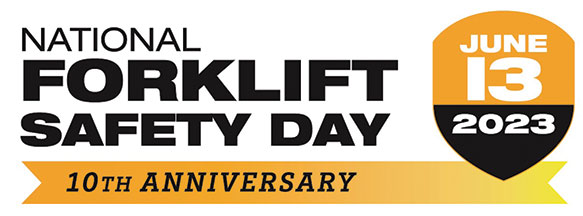Sensors give lift truck safety a boost
Operator-assist technologies that use sensors and cameras to alert lift truck operators of potential collisions with other trucks, pedestrians or obstacles aren’t new, but they’re progressing in capabilities and can be paired with telematics for further insights.
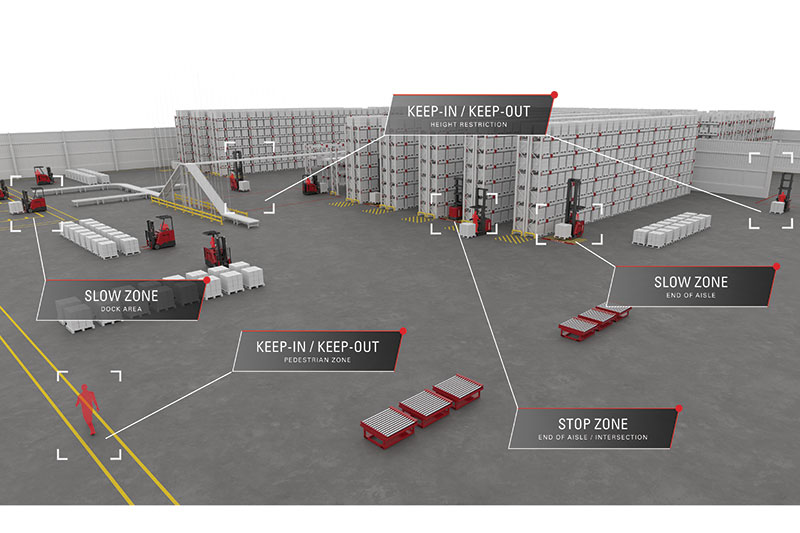
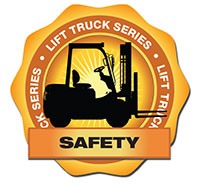
Lift trucks are still the work horses of materials handling. For all the attention on autonomous mobile robots and other forms of robotics, nearly every DC uses manually operated lift trucks to receive goods, crossdock, build pallets for retail store replenishment, or for truck loading, with other duties in between.
Lift trucks also happen to be heavy pieces of equipment, weighing thousands of pounds more than the typical passenger car, and transporting loads that may exceed a couple of tons.
That’s why safe operation of lift trucks is such an important issue. According to the National Safety Council, in 2021, lift trucks were involved in 70 work-related deaths. Additionally, the U.S. Occupational Health and Safety Administration (OSHA) estimates that approximately 70% of forklift incidents could be avoided with proper safety training and policy.
As a result, proper operator safety training remains the most important facet of lift truck safety, which is why the Industrial Truck Association (ITA) makes operator training the focus of National Forklift Safety Day, which this year falls on June 13.
But assuming an operation has a solid training program in place, what else can be done to contribute to safer lift truck use? According to lift truck suppliers, sensor-based technology and alerting systems can help assist drivers in spotting hazards and be more aware of high-risk situations. The capabilities of these various “operator-assist” safety features continue to advance, going well beyond the days of simple back up horns and lights.
Some of these technologies can actively slow down or stop a truck in certain situations, and most will also alert operators audibly and/or visually. These technologies aren’t pitched as safety features, but they are seen as reducing the risk of incidents by making operators more aware of their surroundings and reinforcing best practices and training.
“It’s awesome to see these technologies coming in to enhance work environments,” says Brett Wood, president and CEO of Toyota Material Handling North America and senior executive officer for Toyota Industries Corporation.
Sensing obstacles
DCs can be busy, noisy environments where even a well-trained operator might not see an obstacle left in an aisle or might have a pedestrian inadvertently walk into the path of the truck. Those are the types of risks that object sensing and alerting solutions help guard against.
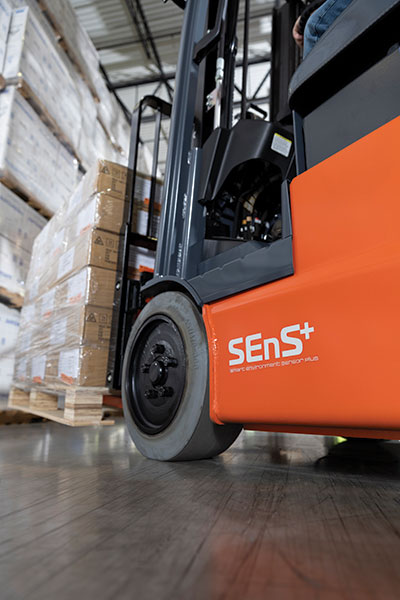
The latest advancement in object detection at Toyota Material Handling is its Smart Environment Sensor (SEnS), which uses a stereoscopic camera to detect pedestrians and objects behind a forklift during operation.
The system uses proprietary algorithms to distinguish between the types of obstacles in view, meaning it can tell the difference between a person or an object like a pallet or cone left in an aisle. SEnS is available as an add-on kit for select Toyota lift trucks.
Toyota also offers SEnS Smart Environment Sensor Plus (SEnS+), an operator-assist system featuring truck slow down as an option for its 3-Wheel Electric forklift and its Core electric forklift. This system offers additional features besides notifications; it can control the speed of the truck in certain situations or slow down the truck for pedestrians or objects under certain conditions.
With dynamic zoning, SEnS+ adjusts the range of detection based on the speed and steering direction of the forklift. If the forklift is moving faster, the zone is expanded to account for potential, upcoming obstacles further away, up to 32 feet. Additionally, if the forklift is stopped and the system detects an object or pedestrian behind it, it automatically limits the truck’s starting movement and speed, even if the operator tries to accelerate.
Importantly, adds Wood, the ability of the stereoscopic technology to adjust to steering direction and speed allows the system to apply speed control in the path of travel, while avoiding false notifications of pedestrians near the truck but not in the detected range of travel.
Toyota also offers its System of Active Stability (SAS) to help prevent tip overs. It uses data from different sensors, including a yaw rate sensor, to detect unstable conditions. If needed, the SAS can automatically take protective action, locking the rear axle to reduce the possibility of tip over.
Pair with telematics
Multiple lift truck technologies can contribute to improved safety, from telematics systems that track safety incidents to sensor-based object and pedestrian detection features, notes Jim Gaskell, director of global automation and emerging technologies at Crown Equipment Corporation. While sensor-based solutions have advanced rapidly, don’t forget about the value of telematics for tracking incident trends and digitizing safety checks.
“The adoption of telematics has been pretty important to tracking incidents and being able to identify who the operator of the truck was at the time of the incident,” Gaskell says. “If you add some location tracking technology to telematics, you can now determine where the incident occurred and also set speed thresholds for specific areas of an operation.”
Meanwhile, object detection technology for lift trucks has improved, with LiDAR sensors able to spot objects within the sensor’s field of view. Ultra-wideband (UWB) anchors can be placed on infrastructure such as ceilings, posts or columns. UWB tags can be placed on forklifts and integrated into employee badges to provide for added object detection and localization capabilities.
These technologies, Gaskell adds, are meant to assist operators by warning them to make safe decisions. In some cases, if a collision or incident is imminent, today’s technologies can actively slow the vehicle.
“The two terms you’ll hear are active and passive warning systems,” Gaskell says. “A passive alert would be a warning tone or haptic alert, whereas an active system can slow the vehicle. This is a safety feature that some customers are requesting on forklifts today. With an active warning system, if anything is detected within the sensor’s field of view, it’s going to start alerting the operator and then slowing the vehicle.”
A comprehensive strategy for enhanced lift truck safety, says Gaskell, is to combine technologies such as telematics, LiDAR, as well as UWB, so operators can have sensor-driven passive and active alerts at their disposal. Each element can help any operation deal with inexperienced operators or an influx of seasonal staff.
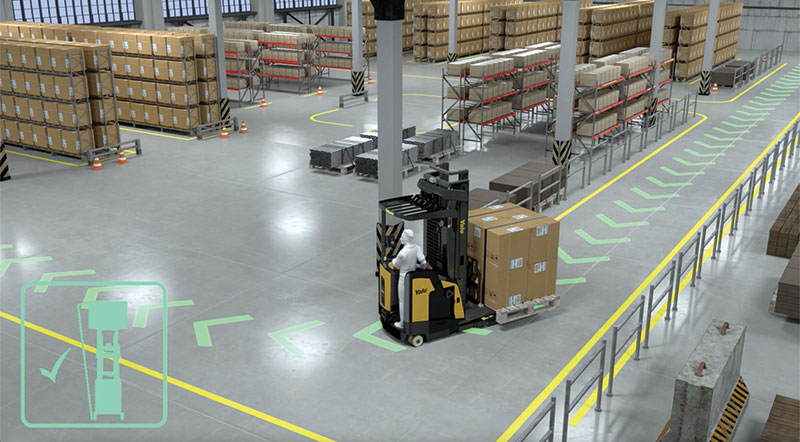
Feedback for operators
While some technology does slow or stop a truck, part of the benefit is the alerting and feedback itself, explains Martin Boyd, vice president of product planning and solutions for the Hyster Company.
For example, the Hyster Dynamic Stability System, available on the new line of Hyster A Series counterbalanced lift trucks, is sensor-based and works to reduce the likelihood of tip overs by monitoring certain operator actions and providing automated performance controls and alerts, says Boyd. It uses a controller that monitors lift height, mast tilt angle, hydraulic load, truck speed and steer angle. The system also is smart enough to actively slow the truck if tip over risk is high, limiting truck performance in certain conditions to minimize the chance of forward or sideways tips overs.
The real-time alerts from DSS help reinforce decisions that support the proper operating practices established during operator training in the here and now, with easily understood icons to show the nature of the unstable condition, such as load too high or speed too high.
“What makes DSS a really good training reinforcement tool is that it does provide feedback to the operator if they inadvertently place the lift truck into an unstable situation where the truck could potentially tip over,” says Boyd. “It’s not just a system that overtakes the control of the truck when the operator isn’t aware of the unstable situation—they have that feedback.”
At Yale Lift Truck Technologies, the Yale Reliant solution provides object detection and sensing capability, using two key types of sensing technology, explains Nic Temple, Yale’s director of emerging technologies, while also providing for active control of the truck, as needed based on designated thresholds.
One of these technologies is LiDAR object detection, designed to detect objects, pedestrians, equipment and infrastructure in the path of travel (forks trailing). Another is proximity detection, which involves UWB tags on trucks or pedestrians. Yale Reliant is available on 18 lift truck models.
“There has definitely been an evolution with operator-assist related technologies, from blue back up lights and on into telematics with impact detection and impact cameras, which provide a means of tracking incidents and reviewing what caused an incident,” says Temple. “But wouldn’t it be nice to have a means of helping to limit the risk of impacts happening in the first place. That’s what Yale Reliant is really targeting: supporting operator awareness to help give them additional time to react and steer away if needed.”
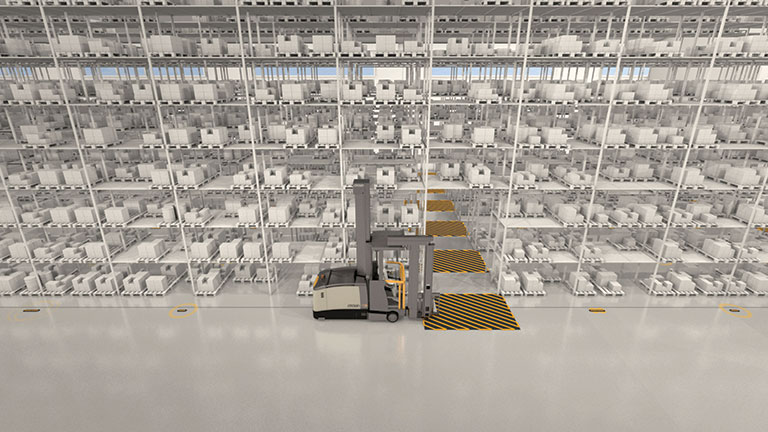
On trucks equipped with Yale Reliant, the system can actively control the speed of the truck, bringing it to a crawl if needed, explains Temple. He adds that Yale’s research suggests that a 10% reduction in speed could be highly noticeable for operators, rather than audible alerts that could get lost among other sounds in what are often noisy environments.
“Just that small reduction in speed provides that additional method of active alert, along with visual indicators, to help the operator regain their situational awareness,” says Temple.
Some of this advanced safety technology is configurable, Temple says. For example, UWB tagging and real-time location technology systems (RTLS) can be leveraged to set user-defined geo-fenced zones, such as automatic slowdown at the ends of aisles or in heavily populated areas, where trucks can only go a definable top speed.
UWB technology creates a “bubble” around each truck or pedestrian tagged in the system, says Temple, so alerts are generated and if not heeded, the truck will stop prior to collision. While solid walls can impede UWB detection in some cases, it can go beyond pure line of sight, such as detecting if a pedestrian walking on the wrong side of an intersecting nearby aisle is headed into the path of a lift truck. “Where two bubbles intersect, that creates the detection event,” says Temple.
UWB sensing and alerting can take into account site-specific factors, adds Temple. For example, if two wire-guided trucks are operating in an aisle, the alerting can be muted so there is no slow down event. The size or diameter of safety bubbles is also configurable. Geo-fencing can also be set up to flag site-specific obstructions like overhead conveyor.
“By having a solution that ensures the forks are lowered and will alert the operator by slowing the truck, even to a crawl if needed in certain situations, the operators will quickly learn, ‘OK, my forks are too high for this area, I need to always have them lower here,’” says Temple. “It’s another level of safety alerting that can be combined with telematics and RTLS to really reduce risk and reinforce proper operator training.”
Reinforce best practices
Various technologies help operators make proper decisions, agrees David Norton, vice president of customer solutions and support at The Raymond Corp., while telematics provides insights on impacts and other safety-related trends, indicating which operators are having more issues.
For example, Raymond’s In-Aisle Detection System (IADS) is an option for Raymond orderpicker and swing reach trucks. IADS uses LiDAR sensors positioned tractor forward to keep trucks separated while on the wire in the aisle.
Additionally, under Raymond’s iWAREHOUSE telematics solution set, UWB anchors and tagging are used to support RTLS for tagged trucks, or pedestrians wearing badges with tags, or placed at key points in a facility.
The system can create slowdown or stopping zones, says Norton, such as at the end of aisles or near a battery charging area. The system can even alert pedestrians wearing a tagged badge if they break operation rules.
System-enforced slow down and stopping points, Norton says, are a way to reinforce proper operator practices. “What this does is reinforces the rules of the road the facility wants to have, like stopping at intersection or stopping at pedestrian crosswalks. And for pedestrians, staying on the pedestrian side of an aisle,” says Norton. “All this data flows into iWAREHOUSE, so we know when specific operators don’t do what we expect them to do, and the truck had to take control. By looking at those insights, we can determine if there is a need for further reinforcement through training.”
Raymond also offers a proximity notification function under its iWAREHOUSE solution called iW.FieldSense designed to alert pedestrians and lift truck operators when they come within a predefined distance of properly equipped trucks and pedestrians. The system uses magnetic field generation technology to emit low frequency pulses to create an adjustable field around each piece of equipment for proximity alerts. The system can also alert operators to proximity of structural elements.
Not every operation is going to need or want the latest sensing options, but when they are applied alongside a rigorous training program, and with telematics on top, operations have a better foundation, says Norton.
“Overall, these technologies help drive consistent behavior around what operators are expected to do,” says Norton. “When you have these sensor technologies, and then the data behind it from telematics, now the operation can work with their associates on best practices on an ongoing basis.”

Article Topics
Crown Equipment News & Resources
Lithium Transition: It’s all about the outcomes Jumping on the narrow aisle trend Your telematics data to-do listLatest in Logistics
FTR’s Trucking Conditions Index falls to lowest level since last September U.S. rail carload and intermodal volumes are mixed, for week ending May 11, reports AAR Cass Freight Index points to annual shipments and expenditures declines ALAN opens up its nominations for 2024 Humanitarian Logistics Awards U.S.-bound import growth remains intact in April, reports Descartes Looking at a reshoring history lesson NTSB: Ship lost power twice before slamming into Baltimore bridge, closing port More LogisticsAbout the Author
Subscribe to Logistics Management Magazine

Find out what the world's most innovative companies are doing to improve productivity in their plants and distribution centers.
Start your FREE subscription today.
May 2024 Logistics Management

Latest Resources


